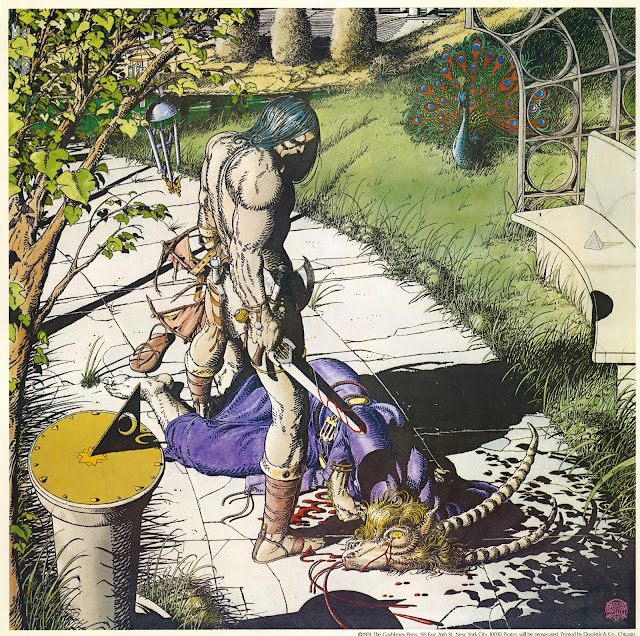Most of the potentially good artists today, it seemed to me, were employing themselves in de-coding a writer's ideas...illustrations that if taken out of context were without meaning, reason or even, and this is by far the least of all, personal intensity... It was my intention to create pictures that either told their own story, or needed no such backgrounds at all. (BWS, 'A Fine Madness', Gorblimey Press Catalogue 1977)
BWS The Ram and the Peacock (images of time and space)
The gorilla in the room is why should so many follow modernity if it has no hierarchy? The answer has to be that it is ultra-convincing to the ego (of acolytes), and words are also convincing used as the handmaiden of 'facts' (for example, McCormick PH4
However, those like McCormick appear to support blandness musically for the reason it fits social conformity; in past decades rock had conviction, which is a force for rebellion.
If you saw the video for 'Fortunate Son', whoever filmed the images chose almost Apple Pie clichés of Americana (with Indians), for a song that's ostensibly rebelling against the draft. Then again, Don McLean's American Pie is exactly that! Rebellion can from some aspect be orthodoxy.
This invites the observation that Washington is run by Martians masquerading as human (as in Carpenter's They Live!) More fundamentally, though, scientific orthodoxy is dessicated, dissected into a form of living death.
The images on 'Fortunate Son' are of expressive movement, so that is another sort of orthodoxy that is fairly tribal (bikers etc.) That sort of orthodoxy carries spirit (zest) and the stars and stripes.
So, orthodoxy in terms of movement is pretty wild (rock), rebelling against scientific orthodoxy, or dessicated death. This obviously creates a heap of confusion. For a start, movement - expression of the body animated by the psyche - carries into a sense of hierarchy, whether it's a biker crew or a neighbourhood or small-town or cowshwd or Indian lodge.
Spirit is something that is given to those that move - it doesn't need to be thought-out. Caravanserai. Spirit is the orthodoxy that opposes the orthodoxy of DNA that is the result of dessicated dissection or living death (meaningless, random.)
BWS's Monsters approaches the theme of genetic mutations as warped Nazi engineering. From what I've seen of the pictures, there is a wordless intensity that relates to a narrative flow of psychic force - quasi-mystical interactions between family members
BWS has then achieved what he set-out in the quote, to produce a self-evident piece of standalone art. The pictures carry a narrative that is more than verbal (personally, I think this applies to other classics like Adams' Avengers and X-Men, both with Roy Thomas.)
Speaking of RT, I jokingly put it to him that BWS is a godlike figure, to which he he hurled abuse. What I meant to imply was that his ambition is more than most and, by achieving the standalone image as a narrative in itself, has a type of transcendence that reaches into the hierarchy of which we are (or were) part.
Lines are movements in time and space, and something innate to art (see prev, da Vinci study for the Virgin of the Rocks.) That entire area of movement and dimensions is the orthodoxy that scientific orthodoxy leaves behind.
In that sense, BWS's Monsters is a rebellion against the dictatorship of measurement (DNA, and the variable time framework we are given by 'them', ie Musk &Co.) Measurement is just another word for perspective, and the logic of electromagnetism, or the parallel reality which acolytes enter (the mirror of illusions.)
Conviction that is felt has a spiritual connotation, while conviction that is not felt has none. That's the difference between felt art and dessicated science (life vs death). Note here that Renaissance art was also a science, or a ience was subsidiary.
Political systems that are a reflection of the scientific view are equally dessicated, as with South African apartheid. Feeling is movement and dimensions, and the ancient orthodoxy of spirit.
"We were rebelling and we were trying to run away from... the regime that whites and blacks couldn't play together." (Louis Maholo of The Blue Notes, 60s South African integrated jazz band)
MAGWAZAyoutu.be/DX7-NJWFtDs (trad arr Johnny Dyani, melancholy spirit, joyful transcendence)

